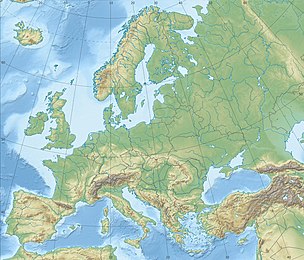| History | |
|---|---|
| Name |
|
| Owner |
|
| Operator |
|
| Port of registry | |
| Builder | Neptun AG |
| Launched | 1899 |
| Out of service | 20 June 1949 |
| Identification | |
| Fate | Scuttled |
| General characteristics | |
| Type | Cargo ship |
| Tonnage | |
| Length | 241 ft 5 in (73.58 m) |
| Beam | 36 ft 1 in (11.00 m) |
| Depth | 16 ft 9 in (5.11 m) |
| Installed power | Triple expansion steam engine |
| Propulsion | Screw propeller |

Empire Conyngham was a 1,408 GRT cargo ship that was built as Marie in 1899 by Neptun AG, Rostock, Germany for German owners. A sale in 1923 saw her renamed Norburg. She was sold to Latvia in 1925 and renamed Gauja, serving until 1941 when she was captured by the Kriegsmarine in the Baltic Sea. In 1945, she was seized by the Allies, passed to the Ministry of War Transport (MoWT) and was renamed Empire Conyngham. In 1946, she was scuttled with a cargo of obsolete bombs.
Description
The ship was built in 1899 by Neptun AG, Rostock.
The ship was 241 feet 5 inches (73.58 m) long, with a beam of 36 feet 1 inch (11.00 m) and a depth of 16 feet 9 inches (5.11 m). She was assessed at 1,501 GRT, 895 NRT.
The ship was propelled by a triple expansion steam engine, which had cylinders of 18 inches (46 cm), 30+1⁄2 inches (77 cm) and 48 inches (120 cm) diameter by 33+1⁄8 inches (84 cm) stroke. The engine was built by Neptun AG.
History
Marie was built for the Flensburger Dampfschiff Gesellschaft, Flensburg. She was operated under the management of H Schuldt. In 1923, she was sold to Ozean Dampschiff AG and was renamed Norburg. In 1925, she was sold to the Latvian Government and was renamed Gauja. Her port of registry was Riga and the Code Letters TBDP were allocated. Gauja was operated under the management of Valsts Kuģu Pārvalde. By 1935, her code letters had been changed to YLCZ and the ship was assessed at 1,408 GRT, 829 NRT.
On 8 June 1941, Gauja was captured by the Kriegsmarine in the Baltic Sea. She was renamed Friedrich and operated by Otto Wiggers, Rostock. Friedrich was captured by the Allies in May 1945. She was passed to the MoWT and renamed Empire Conyngham. Her port of registry was changed to London and the Code Letters GKWN were allocated. On 18 June 1949, Empire Conyngham departed Dartmouth, Devon with a cargo of obsolete bombs. She was escorted by HMS Burghead Bay. On 20 June, she was scuttled in the Bay of Biscay (47°52′N 8°51′W / 47.867°N 8.850°W / 47.867; -8.850).
References
- ^ Mitchell, W.H.; Sawyer, L.A. (1995). The Empire Ships. London, New York, Hamburg, Hong Kong: Lloyd's of London Press Ltd. p. not cited. ISBN 1-85044-275-4.
- ^ "LLOYD'S REGISTER, STEAMERS AND MOTORSHIPS" (PDF). Plimsoll Ship Data. Retrieved 3 November 2010.
- "EMPIRE - C". Mariners. Retrieved 3 November 2010.
- "LLOYD'S REGISTER, NAVIRES A VAPEUR ET A MOTEURS" (PDF). Plimsoll Ship Data. Retrieved 3 November 2010.
- "LLOYD'S REGISTER, NAVIRES A VAPEUR ET A MOTEURS" (PDF). Plimsoll Ship Data. Retrieved 3 November 2010.
- "HMS BURGHEAD BAY (K 622) - Bay-class Frigate". Naval History. Retrieved 3 November 2010.
| Shipwrecks and maritime incidents in June 1941 | |
|---|---|
| Shipwrecks |
|
| Other incidents | |
| 1940 May 1941 | |
| Empire ships | |
|---|---|
| By suffix, Empire x | |
| See also: Fort ship, Liberty ship, Park ship, Ocean ship, Victory ship. |
| Shipwrecks and maritime incidents in 1949 | |
|---|---|
| Shipwrecks |
|
| Other incidents |
|
| 1948 | |
- 1899 ships
- Captured ships
- Empire ships
- Maritime incidents in June 1941
- Maritime incidents in 1949
- Merchant ships of Latvia
- Merchant ships of Germany
- Merchant ships of the United Kingdom
- Ministry of War Transport ships
- Scuttled vessels of the United Kingdom
- Ships built in Rostock
- Shipwrecks in the Bay of Biscay
- Steamships of Latvia
- Steamships of Germany
- Steamships of the United Kingdom
- World War I merchant ships of Germany
- World War II merchant ships of Germany